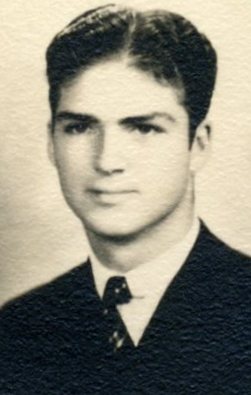On a clear April morning in 1958, United Airlines Flight 736 was struck in the Nevada skies by a United States Air Force fighter jet in training. Both aircraft fell out of control from 21,000 feet and crashed into unpopulated desert terrain southwest of Las Vegas. The dead included the two pilots in the fighter jet and all 42 passengers and five crew members aboard Flight 736. Among the victims were military personnel and civilian contractors involved with sensitive Department of Defense weapons systems, and the FBI was brought in to help identify human remains and to search for any sensitive documents pertaining to national security that may have survived the fiery crash.
First Officer on Flight 736 was former Lakin man Arlin E. Sommers, and the community was stunned upon learning the devastating news. The son of Edd and Bessie Sommers, Arlin was a 1940 Lakin High School graduate. In October of 1939, Arlin became the first scout in Lakin to achieve the rank of Eagle Scout, and he was also a senior patrol leader of Troop 35.
After completing his primary and elementary flight training, Arlin received orders to report for duty at Del Monte, CA in June 1943. That fall, he graduated from the United States Naval Pre-Flight School and reported to the U.S. Naval Air Station in Hutchinson for primary flight training. As a member of the Navy Reserves, Lieutenant Sommers was a pilot in the Naval Air Transport Service and flew DC-4’s on the NATS San Francisco to Guam flight during World War II.
Arlin returned to Lakin after the war and conducted an aerial spraying operation. He was appointed the first commanding officer of the newly organized Kearny County Civil Air Patrol in December 1948, but in early 1951, Arlin and his family relocated to the Denver area after he was hired by United Airlines as a pilot. With 3,700 hours of flying time, Sommers was well trained for the job, and he made rapid progress in the company with United rating him as one of their top flying officers.
On that fatal day of April 21, 1958, Flight 736 was enroute from Los Angeles International Airport to New York City with the first stopover scheduled at Denver. The fighter jet took off from Nellis Air Force Base near Vegas approximately eight minutes after Flight 736 left L.A. In the front seat of the tandem cockpit was Capt. Thomas Coryell, a flight instructor and safety pilot, and behind him was 1st Lt. Gerald D. Moran. As part of Moran’s training, he was under a hood that blocked his view outside the aircraft but allowed him to see his instrument panel. Using two-way microphone communication, Coryell instructed Moran and monitored his performance. Coryell was also to maintain lookout for other aircraft.
The Air Force jet was practicing a maneuver that involved climbing to about 28,000 feet and diving almost straight down to simulate a rapid insertion into enemy airspace when its right wing clipped the airliner’s right wing. A frantic radio call from the stricken airliner came just moments after the collision at 8:30 a.m. “United Air Lines 736. Mayday. Midair collision over Las Vegas. 736.”
The crash remains the deadliest in the history of the Las Vegas Valley and was one of several mid-air collisions during the 1950s that ushered in widespread improvements in air traffic control and led directly to changes in the way airspace nationwide was shared by commercial and military flights. In August 1958, President Dwight Eisenhower specifically referenced the deadly collision as he signed the Federal Aviation Act which ordered the creation of what is now the Federal Aviation Administration.
The Civil Aeronautics Board determined that the probable cause of the collision between Flight 736 and the fighter jet was a high rate of near head-on closure at high altitude; human and cockpit visibility limitations; and the failure of Nellis Air Force Base and the Civil Aeronautics Administration to take every measure possible to reduce a known collision exposure. A trial court later found First Officer Sommers and Flight 736 Captain Duane Ward free from any negligence, and damages were awarded to their wives and children. Arlin Sommers was 36 years old. He and his wife, Noel Jean, had three children, ages 12, 8 and 6.

SOURCES: usarchive.org; casetext.com; bootcampmilitaryfitnessinstitute.com; Ancestry.com; Wikipedia; Archives of the Lakin Independent, Las Vegas Review Journal, and Los Angeles Times; and Museum archives.
